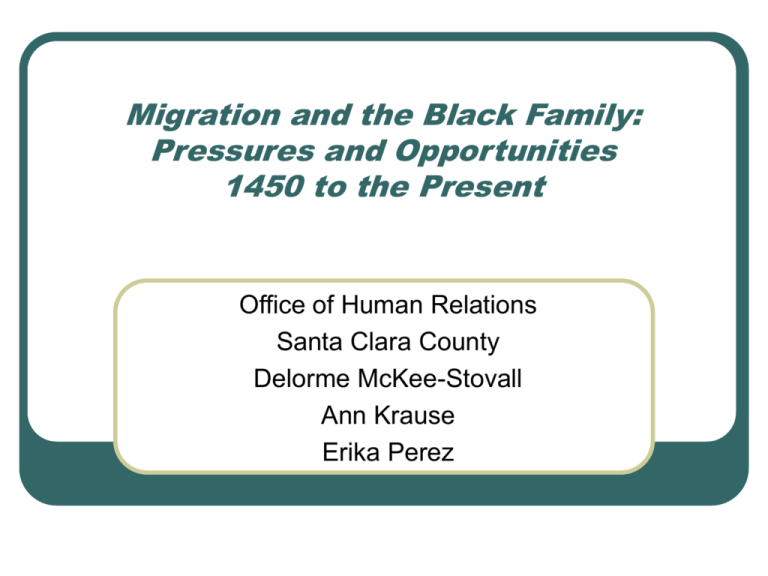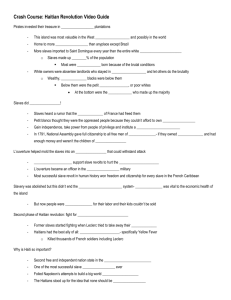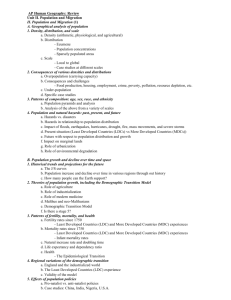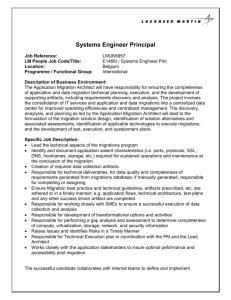Migration and the Black Family: Pressures and Opportunities
advertisement

Migration and the Black Family: Pressures and Opportunities 1450 to the Present Office of Human Relations Santa Clara County Delorme McKee-Stovall Ann Krause Erika Perez Goal for Today’s Presentation To provide a history of the issues and concerns African Americans have faced in their attempt to create and maintain sustainable families in a difficult environment from the time of slavery to the present. 2 The African-American Family Migration Experience Migration has been central in shaping the AfricanAmerican culture and family life. Our focus today is on the effects of four major migrations on the AfricanAmerican family: The Original Migration of Slaves from Africa Migration Out of the South in the Nineteenth Century The “Great Wars Migration” in the Twentieth Century Today’s Migration Back to the South 3 The First Migration: Blacks Come to America as Slaves African Family Selling of African Slaves at Jamestown 4 Map of Migration from Africa to America 5 A Typical Slave Ship 6 Some Data about Slavery Ten to twelve million slaves were brought to the Americas between 1450 and 1860. The majority went to Brazil and the West Indies. Only 500,000 came to North America. Most of the slaves in South and Central America died from the harsh treatment. As a result, slavery did not become established there. By 1860, 3.8 million slaves made up one-third of the population of the Southern states; in the Northern states, there were 500,000 free Blacks. 7 The Selling of Slaves A Slave Auction Inspection 8 Slave Prices for Men and Boys Richmond, 1846 to 1860 9 Slave Prices for Women and Girls Richmond, 1846 to 1860 10 Managing Slaves According to Willie Lynch in 1712 Use fear, distrust, and envy to divide and create conflicts between slaves. - Female vs. male - Old Black male against young Black male - Dark-skinned versus light-skinned “They must love, respect, and trust only us [the white slave owners].” Break them like you break a horse. If you break the female, she will break her offspring. Put the fear of God in the male. The “Language Barrier”: keep them uneducated and unaware. 11 Pictures of Slave Families A Family Separated 12 Pictures of Slave Families A Family Together 13 Slave Efforts to Maintain Families In spite of slave masters’ sole interest in breeding more slaves, slaves engaged in unlawful marriages. “Jumping the Broom” was a ritual to honor their unions. Slaves also formed new kinship relationships. - Slave to slave: blood did not define kinship. - Master to slave: the master defined the kinship based on sex, skin color, and racial anonymity. - Slave to Native Americans: based on mutual consent. 14 Nineteenth Century: Beginnings of the Northern and Western Migrations Moving Out of the South: Disillusioned by Jim Crow laws and attracted by land and jobs, African Americans migrated North and West. 15 Pictures from the Nineteenth Century Migrations Black Exodus from the South via Riverboat 16 Pictures from the Nineteenth Century Migrations Early Homestead in Kansas The Shores Family in Nebraska 17 Pictures from the Nineteenth Century Migrations Black Cowboys Cyclists in Denver 18 Pictures from the Nineteenth Century Migrations Blacks in a Northern City 19 1853 Census of San Jose, CA This census, taken three years after California became a state, shows that Blacks were a part of the early history of San Jose. Male White Negroes Mulattoes Indians Foreign 4,096 53 388 1,059 Female Total 2,062 39 3 162 276 6,158 92 3 550 1,335 20 Nineteenth Century Pressures and Opportunities Pressures: “Racism” Fear of white violence Economic injustice Jim Crow laws Opportunities: “The Promised Land” Urban jobs Land ownership Access to education and skills 21 Jim Crow Laws: Black Codes Purposes: Reverse civil rights gains Promote segregation - Transportation - Use of public facilities - Housing - Restaurants/theaters - Schools Prevent voting - Poll tax - Literacy tests 22 Jim Crow Laws: Black Codes One drop of African blood defined your permanent heritage and status. Looking directly at or touching a white female was a punishable offense. Interracial relationships or marriages were illegal. The legal status of Blacks was equal to 3/5 of a person. Jim Crow laws limited Blacks’ rights to legal recourse. 23 Lynchings The white public sentiment that supported Jim Crow laws also upheld the abhorrent practice of lynching. Of the 5,000 lynchings and 20,000 killings, only 50 individuals were ever brought to trial. It is estimated that over 10,000 individuals witnessed these acts of brutality. 24 Twentieth Century: The “Great Wars Migrations” to Industrial Areas The First and Second World Wars created a demand for labor in Northern and Western cities. Thus began the transformation of the African-American population from a predominantly rural to a predominantly urban people. 25 Black Population Trends The Change from Southern Rural to Northern Urban Southern Rural Northern Urban 1890 90.3% 90% 9.7% 10% 1960s 10% 5% 90% 95% 26 Pictures from the Twentieth Century Migrations 27 Pictures from the Twentieth Century Migrations Ford Assembly Line 28 Pictures from the Twentieth Century Migrations Harlem in the Twenties: The Harlem Renaissance 29 Pictures from the Twentieth Century Migrations Woman Aircraft Worker during WW II Housing in Detroit 30 Pictures from the Twentieth Century Migrations Middle Class Family 31 Segregation in the Forties 32 Boycott of Woolworth and Kress Stores in San Jose in the Fifties 33 1900-1960 Pressures and Opportunities Pressures Jim Crow laws: segregation Cultural insensitivity Social welfare Opportunities Jobs Community Integration: education and housing 34 The Sixties: Time of Radical Change MLK and Gandhi “I have a dream” Speech 35 The Sixties: Time of Radical Change Stokely Carmichael and the SDS Black Panthers 36 1960 to 2000 Pressures and Opportunities Pressures Cultural insensitivity Economic and racial discrimination Opportunities Civil rights Black Power movements 37 Current Migration Trend: Back to the South Starting in the 1970s, there has been a reverse migration to the South as prospects for Blacks have improved there. As Maya Angelou observed, many African Americans have found that they can come home again. 38 Pictures from the Current Migration to the South New Opportunities for a Better Life 39 Pictures from the Current Migration to the South The New Little Rock 40 Pictures from the Current Migration to the South A Battle Won? 41 Decreasing Black Population in Santa Clara County Santa Clara County Black Census 1970 1980 1990 2000 2005 18,000 42,835 55,365 47,182 42,307 1.7% 3.3% 3.7% 2.8% 2.5% Are they going to the South also? 42 Current Black Families Pressures and Opportunities Pressures Cultural insensitivity Shifting demographics and economics Opportunities Community Jobs Home ownership 43 Looking toward the Future It isn’t where you came from. It’s where you’re going that counts. -- Ella Fitzgerald 44 For Further Study Much of the information and imagery for this presentation was taken from the web site “In Motion: The African-American Migration Experience.” http://www.inmotionaame.org 45







